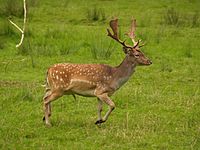
Photo from wikipedia
Knowledge of reproductive characteristics of wild populations is necessary to inform responsible management decisions that promote herd health. As management, goals, and free-ranging populations change over time and landscapes, updated… Click to show full abstract
Knowledge of reproductive characteristics of wild populations is necessary to inform responsible management decisions that promote herd health. As management, goals, and free-ranging populations change over time and landscapes, updated knowledge of reproductive characteristics are needed to inform responsible management practices. We estimated reproductive characteristics of female white-tailed deer in Illinois, including pregnancy rate, litter size, fetal growth and fetal sex ratio. We found maternal age to have an important influence on several reproductive factors. Approximately 66% of tested females (n = 3884) were pregnant and pregnancy rates increased with increasing maternal age, from 20.5% in fawns to 85.8% in adult deer. Litter size ranged from 1 to 5 fetuses per pregnant female. The average litter size was 1.9 ± 0.54 fetuses per pregnant female and also increased with age, from 1.2 in fawns to 2.0 in adults, respectively. Breeding season peaked in November with the mean estimated conception dates of fetuses varying with maternal age. Fawns conceived fetuses later in the breeding season (December 2) compared to yearlings and adults (November 11 and 8, respectively). We measured the body mass index (BMI) of all fetuses and found that litter size and female age influence fetal size. We found no bias in fetal sex ratio (average 1.0:1.0, male:female) but we observed a sex bias in fetal size (mean BMI male = 0.71, female 0.67) across all maternal age classes. A comparison of the current study and previous reports indicate that variation in maternal age within a population is an important driver of reproductive metrics, likely because maternal age and body size or condition are related. Furthermore, variation in resource availability will influence reproductive rates, especially among fawn females.
Journal Title: Theriogenology
Year Published: 2017
Link to full text (if available)
Share on Social Media: Sign Up to like & get
recommendations!